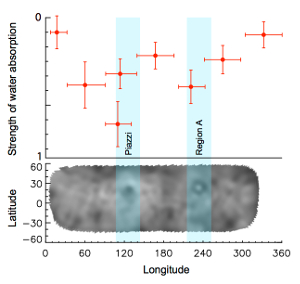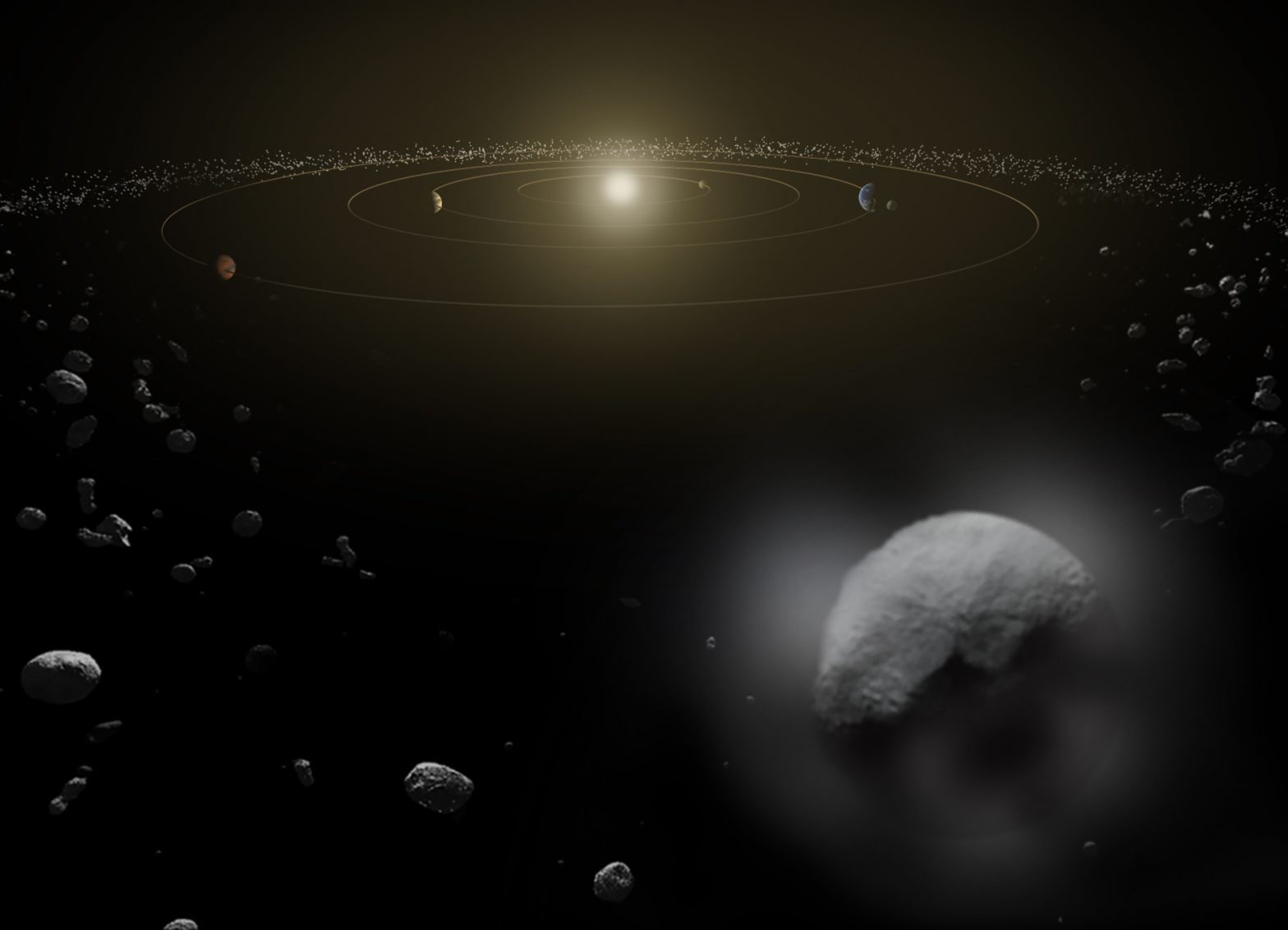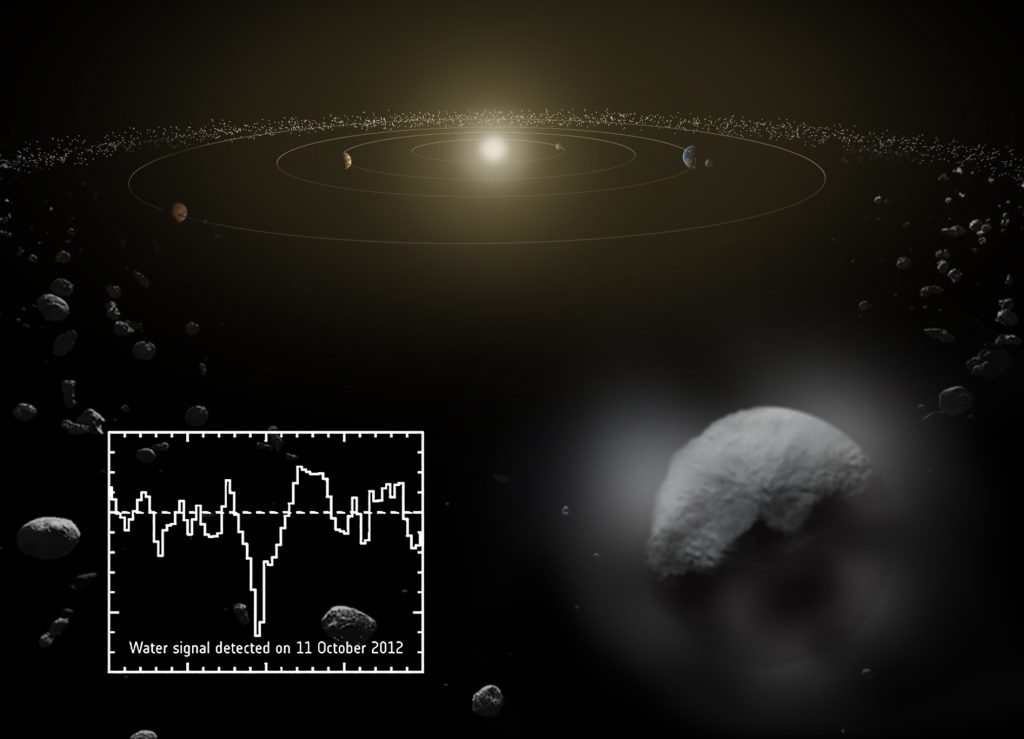| Basic Information | |
| What is this? | An artist’s impression of Ceres, a dwarf planet in the asteroid belt |
| Where is it in the sky? | It moves around the sky as it orbits the Sun, but can currently be found in the constellation of Virgo |
| How big is it? | Around 950km across, and the largest object in the asteroid belt |
| How far away is it? | It orbits around 2.7 times further from the Sun than the Earth |
| What do the colours represent? | Herschel detected the absorbtion due to water vapour at very specific wavelengths, or colours, of infrared light |
Downloads
See this object in:
The asteroid belt lies between the orbits of Mars and Jupiter, around 2-3 times further from the Sun than the Earth is. There are millions of asteroids orbiting there, the left-overs from the formation of the planets 4.5 billion years ago. Of all of these Ceres is by far the largest, and with a diameter of 950 km is almost twice the size of its closest rival.
Because it is so large, Ceres is almost spherical, and is classed as a dwarf planet – the same classification as Pluto. Its size also means that it is thought to have a layered interior, possibly with rock in the centre and ice around the outside. The amount of water ice present on Ceres, and other asteroids, has important implications for out understanding of how the Solar System formed and evolved.
Until now, no definitive detection of water in the asteroid belt has been made, though there have been signs that it is present. Some asteroids have been seen to undergo comet-like outbursts, with material being ejected from their surface. Now, using the HIFI instrument on Herschel, scientists have collected data that point to water vapour being emitted from the the icy surface of Ceres. The measurements were made by measuring far-infrared light at a wavelength which is absorbed by water vapour, with the amount of light absorbed indicating the amount of water vapour present.
“This is the first time that water has been detected in the asteroid belt, and provides proof that Ceres has an icy surface and an atmosphere,” says Michael Küppers of ESA’s European Space Astronomy Centre in Spain, lead author of the paper published in the journal Nature.
“We estimate that approximately 6 kg of water vapour is being produced per second, requiring only a tiny fraction of Ceres to be covered by water ice, which links nicely to the two localised surface features we have observed,” says Laurence O’Rourke, Principal Investigator for the Herschel asteroid and comet observation programme called MACH-11, and second author on the Nature paper.
With temperatures on the surface of Ceres never rising above -40 C, and dropping below -130 C by the evening, it is far too cold for liquid water to be present. The most straightforward explanation of the water vapour production is through sublimation, whereby ice is warmed and transforms directly into gas, dragging the surface dust with it, and thus exposing fresh ice underneath to sustain the process. This is a the process that causes comets to develop extensive atmospheres and tails when they approach the Sun.

The observations were made in November 2011, October 2012, and March 2013. By taking measurements at different times during the 9 hour rotation period of Ceres, the team was able to show that the activity various over the surface, as shown on the right. The two emitting regions, called “Piazzi” and “Region A” are about 5% darker than the average on Ceres. Able to absorb more sunlight, they are then likely the warmest regions, resulting in a more efficient sublimation of small reservoirs of water ice. The two measurements of the Piazzi region were made just 9 hours apart, in which time Ceres had rotated once, showing that the activity can vary over relatively short periods of time.
An alternative possibility for the observed activity is crovolcanism – where geysers or icy volcanoes spew water vapour into the atmosphere. Such processes have been observed on moons of the outer planets, but require a way of generating heat internally, something which is thought to be unlikely on Ceres.
Much more detailed information on Ceres is expected soon, as NASA’s Dawn mission is currently en route there for an arrival in early 2015. It will provide close-up mapping of the surface and monitor how the water activity is generated and varies with time, both on short timescales and as Ceres gets closer and further from the Sun over the course of its 4.5 year orbit.
“Herschel’s discovery of water vapour outgassing from Ceres gives us new information on how water is distributed in the Solar System. Since Ceres constitutes about one fifth of the total mass of asteroid belt, this finding is important not only for the study of small Solar System bodies in general, but also for learning more about the origin of water on Earth,” says Göran Pilbratt, ESA’s Herschel Project Scientist.
Detailed Information
- Herschel discovers water vapour around dwarf planet Ceres – ESA Website
- Herschel Telescope Detects Water on Dwarf Planet NASA JPL website



Comments are closed.